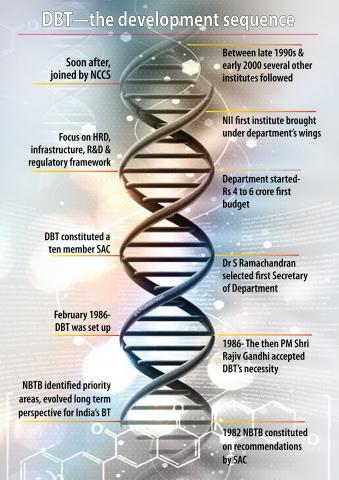The remarkable march of India into the world of bio-sciences and technological advances began in 1986. That year, the then Prime Minister of the country, late Rajiv Gandhi accepted the vision that unless India created a separate Department for Biotechnology, within the Ministry of Science and Technology, Government of India the country would not progress to the desired extent. This was because many of our macro-economic issues of growth were subsumed within that science’s development.
That decision has made India one of the first countries to have a separate department for this stream of science and technology. However the initiation of deliberations to establish the department started much earlier In 1982, after detailed deliberations with the scientific community, and on the basis of recommendations by the then Scientific Advisory Committee to the Cabinet, a National Biotechnology Board (NBTB) was constituted by the Government to identify priority areas and evolve long term perspective for Biotechnology in India. It was also responsible for fostering programme and strengthening indigenous capabilities in this newly emerging discipline.
The NBTB was chaired by the formidable scientist Professor MGK Menon, the then Member (Science) of India’s Planning Commission. All the Secretaries to the various departments of the government dealing with science were appointed as Members of this Board. A separate Department of Biotechnology (DBT) was finally set up in February, 1986 and the NBTB selected Dr S Ramachandran as the first Secretary of the department. The DBT constituted a ten member Scientific Advisory Committee (SAC) with heads of various scientific agencies and a seven member Standing Advisory Committee for North America SAC (0) to ensure that the Department kept abreast of global developments in the field of Biotechnology.
Dr S Ramachandran, says that Prime Minister Shri Rajiv Gandhi recognized that the pace at which biological sciences were growing globally, that “unless we leap forward, there is no way of catching up with the rest of the world”. So space was allocated to a small team to sit in the now sprawling and modern CGO Complex, at Lodhi Road, New Delhi, to set up the DBT. According to Dr Ramachndran the Department started with a modest beginning of around Rs 4 to 6 crores as its first budget.
- There were many serious challenges at the start. First, there were inter-departmental conflicts with no department willing to part with its earlier responsibilities to a new but specialized body.
- The second most important problem was the “tendency of Indian scientists to publish only in national journals” because publishing in international and solidly peer-reviewed journals took too long.
- Third, the industry could not be persuaded early to join hands as governmental procedures took too long.
- The fourth major obstacle was procuring scientific equipment and reagents and other vital necessities for lab research.
In those days in the country, not too many people were working on bio-sciences. The department had, therefore, to focus on
- Developing human resources
- Creation of appropriate infrastructure
- Research and development
- Creating a regulatory framework
Despite the challenges, the department started to roll on almost as soon as it was formed. The first autonomous institute, the National Institute of Immunology which was set up in 1981 was brought under the wings of DBT. Soon after, it was joined by the National Facility for Animal Tissue and Cell Culture of Pune formed in 1986 which was later christened the National Centre for Cell Science. The late 1990s and early 2000 saw many other institutes like The National Institute for Plant Genome Research (NIPGR), the National Brain Research Centre (NBRC) followed, the Centre for DNA Fingerprinting & Diagnostics, Institute of Bioresources and Sustainable Development and the Institute of Life Sciences take shape. Subsequently, several other prominent institutes like Translational Health Science and Technology Institute (THISTI), Institute for Stem Cell Biology and Regenerative Medicine (INstem), National Agri-Food Biotechnology Institute (NABI) at Mohali, and National Institute of Biomedical Genomics (NIBMG) at Kalyani in West Bengal were established.
There is also renewed effort on social aspects such as health care, food and agriculture, energy and environmental security. International collaborations have become more strategic, with better reach and breadth and industry partnerships are growing. The new focus on Young India is clear from the various Grants and Funds as well as Awards, and the DBT’s commitment to revisit the funding mechanism to ensure a quicker assessment of project values and disbursements of funds for research.
This has been the journey, in short, till now.
The future is bright with DBT collaborating with industry on new programme. We welcome all stakeholders to join this historic march forward!

















